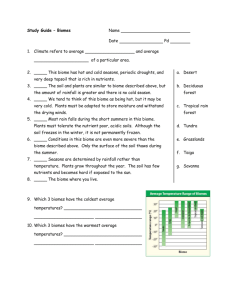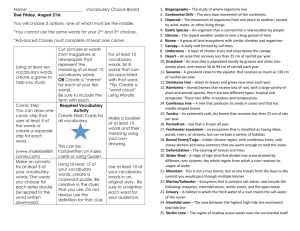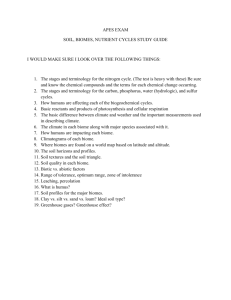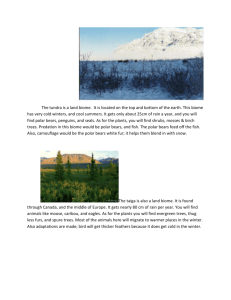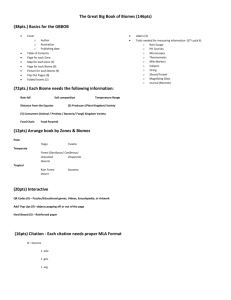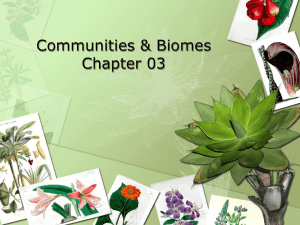Biome Fact Sheet
advertisement
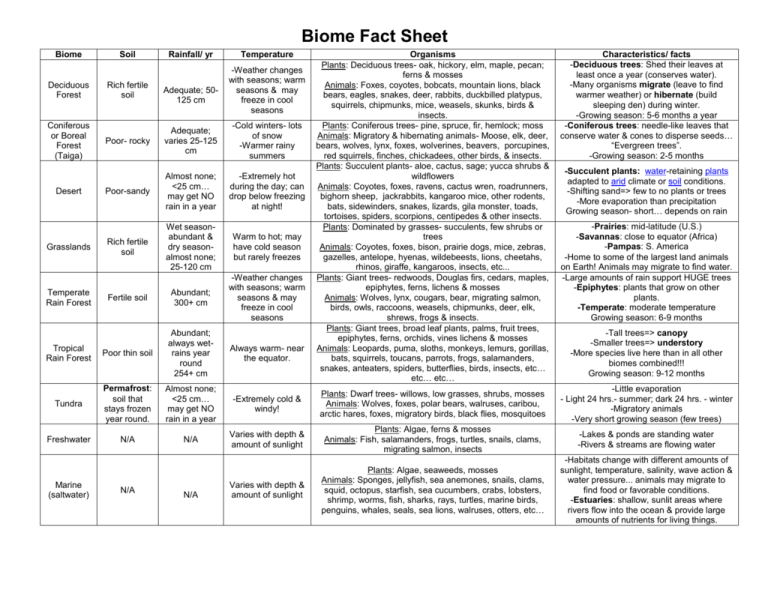
Biome Fact Sheet Biome Deciduous Forest Coniferous or Boreal Forest (Taiga) Soil Rich fertile soil Rainfall/ yr Adequate; 50125 cm Temperature -Weather changes with seasons; warm seasons & may freeze in cool seasons Organisms Plants: Deciduous trees- oak, hickory, elm, maple, pecan; ferns & mosses Animals: Foxes, coyotes, bobcats, mountain lions, black bears, eagles, snakes, deer, rabbits, duckbilled platypus, squirrels, chipmunks, mice, weasels, skunks, birds & insects. Plants: Coniferous trees- pine, spruce, fir, hemlock; moss Animals: Migratory & hibernating animals- Moose, elk, deer, bears, wolves, lynx, foxes, wolverines, beavers, porcupines, red squirrels, finches, chickadees, other birds, & insects. Plants: Succulent plants- aloe, cactus, sage; yucca shrubs & wildflowers Animals: Coyotes, foxes, ravens, cactus wren, roadrunners, bighorn sheep, jackrabbits, kangaroo mice, other rodents, bats, sidewinders, snakes, lizards, gila monster, toads, tortoises, spiders, scorpions, centipedes & other insects. Plants: Dominated by grasses- succulents, few shrubs or trees Animals: Coyotes, foxes, bison, prairie dogs, mice, zebras, gazelles, antelope, hyenas, wildebeests, lions, cheetahs, rhinos, giraffe, kangaroos, insects, etc... Plants: Giant trees- redwoods, Douglas firs, cedars, maples, epiphytes, ferns, lichens & mosses Animals: Wolves, lynx, cougars, bear, migrating salmon, birds, owls, raccoons, weasels, chipmunks, deer, elk, shrews, frogs & insects. Plants: Giant trees, broad leaf plants, palms, fruit trees, epiphytes, ferns, orchids, vines lichens & mosses Animals: Leopards, puma, sloths, monkeys, lemurs, gorillas, bats, squirrels, toucans, parrots, frogs, salamanders, snakes, anteaters, spiders, butterflies, birds, insects, etc… etc… etc… Characteristics/ facts -Deciduous trees: Shed their leaves at least once a year (conserves water). -Many organisms migrate (leave to find warmer weather) or hibernate (build sleeping den) during winter. -Growing season: 5-6 months a year -Coniferous trees: needle-like leaves that conserve water & cones to disperse seeds… “Evergreen trees”. -Growing season: 2-5 months Poor- rocky Adequate; varies 25-125 cm -Cold winters- lots of snow -Warmer rainy summers Poor-sandy Almost none; <25 cm… may get NO rain in a year -Extremely hot during the day; can drop below freezing at night! Rich fertile soil Wet seasonabundant & dry seasonalmost none; 25-120 cm Warm to hot; may have cold season but rarely freezes Fertile soil Abundant; 300+ cm -Weather changes with seasons; warm seasons & may freeze in cool seasons Tropical Rain Forest Poor thin soil Abundant; always wetrains year round 254+ cm Always warm- near the equator. Tundra Permafrost: soil that stays frozen year round. Almost none; <25 cm… may get NO rain in a year -Extremely cold & windy! Plants: Dwarf trees- willows, low grasses, shrubs, mosses Animals: Wolves, foxes, polar bears, walruses, caribou, arctic hares, foxes, migratory birds, black flies, mosquitoes -Little evaporation - Light 24 hrs.- summer; dark 24 hrs. - winter -Migratory animals -Very short growing season (few trees) Freshwater N/A N/A Varies with depth & amount of sunlight Plants: Algae, ferns & mosses Animals: Fish, salamanders, frogs, turtles, snails, clams, migrating salmon, insects -Lakes & ponds are standing water -Rivers & streams are flowing water Varies with depth & amount of sunlight Plants: Algae, seaweeds, mosses Animals: Sponges, jellyfish, sea anemones, snails, clams, squid, octopus, starfish, sea cucumbers, crabs, lobsters, shrimp, worms, fish, sharks, rays, turtles, marine birds, penguins, whales, seals, sea lions, walruses, otters, etc… -Habitats change with different amounts of sunlight, temperature, salinity, wave action & water pressure... animals may migrate to find food or favorable conditions. -Estuaries: shallow, sunlit areas where rivers flow into the ocean & provide large amounts of nutrients for living things. Desert Grasslands Temperate Rain Forest Marine (saltwater) N/A N/A -Succulent plants: water-retaining plants adapted to arid climate or soil conditions. -Shifting sand=> few to no plants or trees -More evaporation than precipitation Growing season- short… depends on rain -Prairies: mid-latitude (U.S.) -Savannas: close to equator (Africa) -Pampas: S. America -Home to some of the largest land animals on Earth! Animals may migrate to find water. -Large amounts of rain support HUGE trees -Epiphytes: plants that grow on other plants. -Temperate: moderate temperature Growing season: 6-9 months -Tall trees=> canopy -Smaller trees=> understory -More species live here than in all other biomes combined!!! Growing season: 9-12 months Characteristics of Biomes Checklist Use the Biome Fact Sheet & Biome Map and place a check in the boxes in the characteristics that apply to each biome. Characteristic Fertile soil Migrating animals Few trees Little to no rainfall Can freeze Short growing seasons Succulent plants Adequate rainfall Warm / hot weather Frozen soil Abundant rainfall Poor soil Always cold Mosses Numerous (large) trees Located on all continents Located on or near equator Only in Northern Hemisphere Supports the most species Desert Tundra Coniferous/ Boreal Forest Deciduous Forest Grassland Tropical Rain Forest Temperate Rain Forest Determine which biome(s) match the following scenarios and fill in the blanks: 1. The growing season in this biome can last all year. ______________________________ 2. This biome can experience the greatest difference between high and low temperature in a single day. ______________________________ 3. Two biomes where animals are most likely to hibernate. __________________________________________ 4. Two biomes where animals would most likely burrow underground for protection or to escape the heat. __________________________________________ 5. Two biomes with little evaporation. __________________________________________ 6. Biome that supports some of the largest land animals on Earth like buffalo, elephants, hippopotamus, giraffes, and rhinoceros. ______________________________ 7. Biome that can experience 24 hours of sunlight or darkness. ______________________________ 8. Biome where you are most likely to find evergreen trees. ______________________________ 9. Biome where you might find dwarf trees because of the short growing season. _________________________ 10. Two biomes that are NOT determined based on the amount of rainfall they receive or the type of soil they have. __________________________________________

